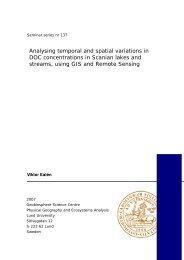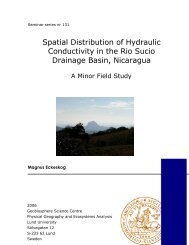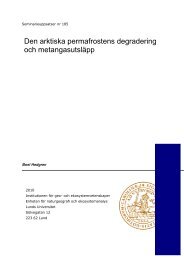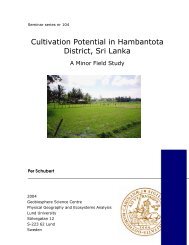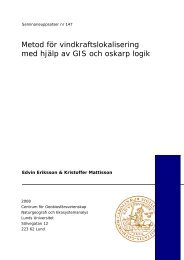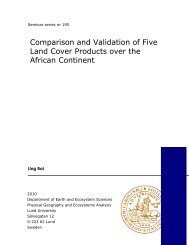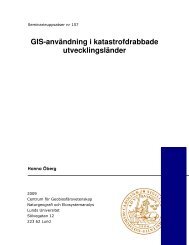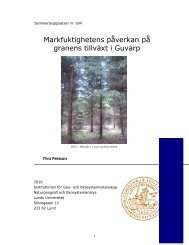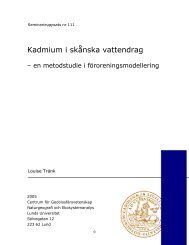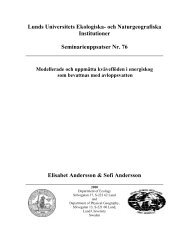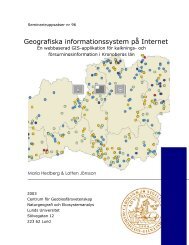Finding Potential Sites for Small-Scale Hydro Power in Uganda: a ...
Finding Potential Sites for Small-Scale Hydro Power in Uganda: a ...
Finding Potential Sites for Small-Scale Hydro Power in Uganda: a ...
You also want an ePaper? Increase the reach of your titles
YUMPU automatically turns print PDFs into web optimized ePapers that Google loves.
unexpla<strong>in</strong>able <strong>for</strong> us. In order to avoid the noise, a split of the <strong>in</strong>put data is necessary,because of some reason the noise does not occur when us<strong>in</strong>g smaller areas. Theseoutputs can then be merged together to <strong>for</strong>m a mosaic of the complete area. Theproblem with this solution is that when divid<strong>in</strong>g the area <strong>in</strong>to smaller areas, thewatercourses could get cut off and cause loss of potential sites. Because of this problemwe chose to use the whole study area as <strong>in</strong>put data, despite the occurance of noise.Our criterion <strong>for</strong> rivers to be a potential site is to have of a height difference of 20meters over a distance of 100 meters. The algorithm is today designed <strong>in</strong> a way thatmakes it possible <strong>for</strong> the ten connection pixels to exceed the 100-meter criterion. Thishappens if the river pixels <strong>in</strong> the data set connect diagonally. If all cells should connectdiagonally the distance would be 141 meters <strong>in</strong>stead of 100, s<strong>in</strong>ce the hypotenuse is 14.1meters if the pixel size is 10 meters. To avoid this problem, it would have been preferableto change the syntax to stop after 100 meters <strong>in</strong>stead of 10 pixels. Because of the limitedtime and that the criterion of a 100-meter distance only is a recommended approximatemeasure, we decided to use the algorithm <strong>in</strong> its present state.6.4 Post process<strong>in</strong>gOur method was expected to be based on four different criteria, mentioned <strong>in</strong> theIntroduction. The sites should have a permanent watercourse, have a specified heightdifference, be <strong>in</strong> vic<strong>in</strong>ity of a village and not be <strong>in</strong> an unsuitable area. We succeeded tofulfill these criteria, except <strong>for</strong> the sites to be <strong>in</strong> vic<strong>in</strong>ity of a village. There are tworeasons <strong>for</strong> this and one is that there were no digital data cover<strong>in</strong>g villages available. Thesecond and most important reason is that the village pattern has a completely differentcomposition, compared to Sweden. What we expected was that clusters of houses wouldrepresent the villages. Instead the <strong>Uganda</strong>n countryside consists of evenly scatteredhouses, with only theoretical village boundaries separat<strong>in</strong>g one village from another. Thereason <strong>for</strong> hav<strong>in</strong>g this criterion was to receive a selection of rivers <strong>in</strong> direct vic<strong>in</strong>ity ofvillages, but because of the actual village pattern, all rivers are <strong>in</strong> vic<strong>in</strong>ity of villages.When this criterion appeared to be superfluous we chose to present the result aspotential sites coupled to population density data at Sub-County level (see Figure 5.10).6.5 Evaluation of <strong>Potential</strong> <strong>Sites</strong>A reason to why we only evaluated 14 potential sites was our unfamiliarity to thecoord<strong>in</strong>ate systems <strong>in</strong> <strong>Uganda</strong>, which resulted <strong>in</strong> that we could not use our GPS <strong>in</strong> theprocess of locat<strong>in</strong>g evaluation sites. All used digital maps over <strong>Uganda</strong> are <strong>in</strong> Arc 196061



